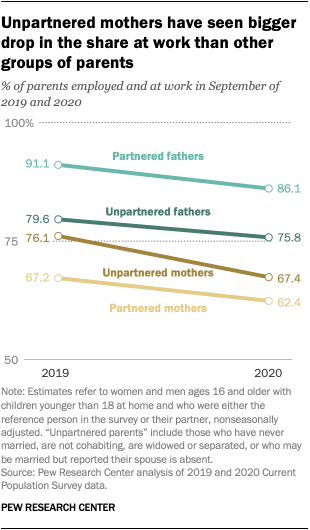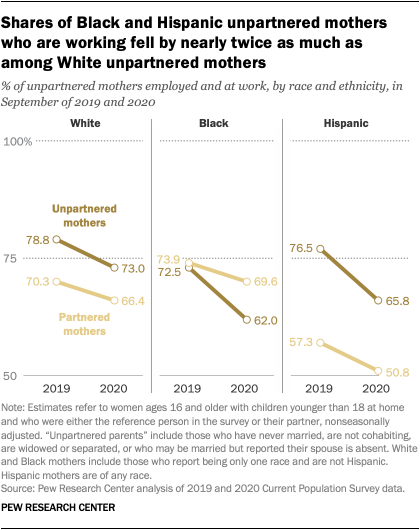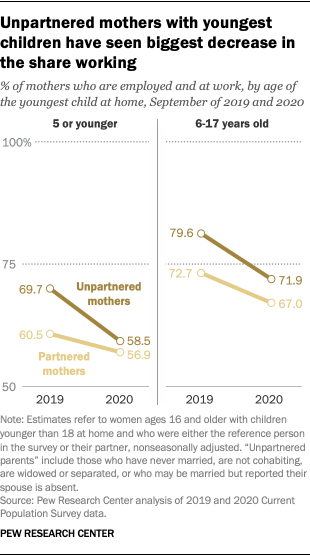Balancing work and family obligations is a challenge for many parents, but remote learning and the closure of many child care centers have put added stress on them in the COVID-19 pandemic, especially on parents without the support of a partner at home.
While previous research on the labor market shows that the pandemic has similarly affected mothers and fathers overall from September 2019 to September 2020, a new Pew Research Center analysis finds that the share of unpartnered mothers who are employed and at work has fallen more precipitously than among other parents.
In September 2020, six months since the onset of the COVID-19 outbreak, 67.4% of unpartnered mothers with children younger than 18 at home were working – employed and on the job – compared with 76.1% in September 2019. This 9 percentage point drop is the largest among all groups of parents, partnered or not. Unpartnered fathers experienced a less severe decrease (4 points), about the same as the drop seen by partnered mothers and fathers (about 5 points each).
This analysis compares the impact of the COVID-19 pandemic on partnered and unpartnered parents when it comes to how they fared in the labor market. The focus is on the shares of partnered and unpartnered mothers who are employed and at work, not absent for any reason. Absences from work, including for vacations, sick leave, maternity or paternity leave, child care or family obligations, vary seasonally. Among women, the number employed and at work is typically lower in the summer months. For these reasons, our analysis focuses on changes from 2019 to 2020, largely eliminating the effect of seasonal variations.
Most estimates in this report are from a Pew Research Center analysis of data from the Current Population Survey (CPS), a survey of U.S. households conducted by the Bureau of Labor Statistics. The COVID-19 outbreak has affected data collection efforts by the U.S. government in its surveys, limiting in-person data collection and affecting the response rate. It is possible that some measures of labor market activity are and how they vary across demographic groups are affected by these changes in data collection.
“Mothers” and “fathers” refer to women and men 16 and older who are either the reference person in the survey or their partner, and who have a child younger than 18 living in the household. Grandchildren and foster children are included in the count of children.
The term “unpartnered” refers to those who either never married or are not cohabiting. Married parents who reported that their spouse is absent are also included in this group, as are parents who are separated or widowed. “Partnered” refers to those who are married, with spouse present, or those with a partner or cohabiter present, opposite sex or not.
The term “employed and at work” refers to employed workers, full-time or part-time, who are not absent from work for any reason. Some reasons why a worker may be absent from work are vacations, maternity or paternity leave, child care and family obligations, or a labor dispute. The labor force consists of people 16 and older who are either employed or actively looking for work. A worker who is not employed must be actively seeking work to be counted among the unemployed. The terms “unemployed” and “not employed” are used interchangeably in this report.
Black and Hispanic unpartnered mothers each experienced about a 10-point decline in the share employed and at work from September 2019 to September 2020. This was nearly double the decrease in the share of White unpartnered mothers who are working (about 6 points). The decreases in the shares of Black and Hispanic unpartnered mothers at work are also nearly double what their partnered counterparts experienced in this yearlong period.
The decline in the share of unpartnered mothers employed and at work is particularly pronounced among those whose youngest child is 5 years old or younger. In September 2020, 58.5% of unpartnered moms in this group were employed, down from 69.7% a year earlier. Unpartnered mothers whose youngest child is 6 to 17 years old also saw a drop, but not as steep – from 79.6% in September 2019 to 71.9% in September 2020. In this same time frame, there was about a 4-point drop among partnered moms whose youngest child is 5 years old or younger (from 60.5% to 56.9%) and a roughly 6-point drop for those whose youngest child is 6 to 17 years old (from 72.7% to 67.0%). Regardless of relationship status, mothers are generally more likely to be employed and at work if they have older children.
Unpartnered mothers with young children at home also saw more of a decrease in labor force participation — that is, the percentage of the population 16 or older actively working or looking for work — from September 2019 to September 2020 than did other mothers. The labor force participation rates declined about 7 percentage points for unpartnered mothers whose youngest child is 5 years old or younger, compared with a 3-point drop for those whose youngest child is 6 to 17 years old. The labor force participation rate for partnered mothers edged down by 1 point for those whose youngest child is 5 years old or younger and dropped about 3 points for those whose youngest child is 6 to 17 years old.
The disproportionate impact of pandemic-related job loss on unpartnered mothers reflects, at least in part, the demographic characteristics of this group. Black women made up 31.4% of unpartnered mothers in September 2020, compared with only 12.2% of all mothers older than 16. When it comes to education, 26.9% of unpartnered mothers had at least a bachelor’s degree, compared with 43.3% of all mothers 16 and older. As previous research shows, the pandemic recession has hit certain groups, such as Black and Hispanic women and those with less education, particularly hard.
Overall, women are more likely to be unpartnered parents than men. In September 2020, 19.7% of mothers living with children younger than 18 at home had no partner present, a much higher share than among fathers (4.7%). Unpartnered mothers are more likely than unpartnered fathers to live with young children. Some 33.6% of unpartnered mothers live with children younger than 6, compared with 25.9% of unpartnered fathers.


"work" - Google News
November 25, 2020 at 02:45AM
https://ift.tt/374L4Jp
Amid COVID-19 recession, unpartnered mothers less likely to be at work - Pew Research Center
"work" - Google News
https://ift.tt/3bUEaYA
Bagikan Berita Ini

















0 Response to "Amid COVID-19 recession, unpartnered mothers less likely to be at work - Pew Research Center"
Post a Comment